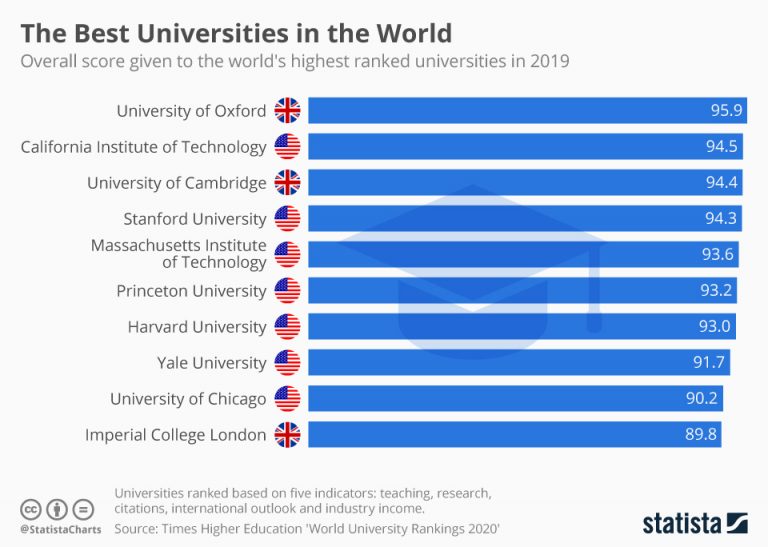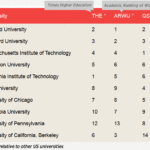Best universities in the world us news – Best Universities in the World: US News Rankings offer a comprehensive guide to the top institutions globally, influencing both student aspirations and institutional strategies. The rankings, based on a complex methodology, evaluate universities across various criteria, including academic reputation, research output, and student outcomes. This detailed analysis delves into the intricacies of these rankings, exploring their impact on universities and the broader landscape of higher education.
The US News & World Report rankings have become a significant benchmark for university excellence, influencing student choices, faculty recruitment, and funding allocation. However, the rankings are not without their critics, with some arguing that they prioritize certain aspects of university performance over others. This exploration will examine the benefits and drawbacks of these rankings, exploring alternative methods of evaluating university quality.
Understanding the US News & World Report Rankings
The US News & World Report’s global university rankings are a widely recognized and influential measure of academic excellence. The rankings aim to provide a comprehensive and objective assessment of universities worldwide, considering a range of factors that contribute to their overall reputation and performance.
Methodology of the Rankings
The US News & World Report employs a sophisticated methodology to determine its global university rankings. The methodology is based on a weighted average of thirteen indicators, each contributing to a different aspect of a university’s overall standing. These indicators are grouped into six categories:
- Global Research Reputation: This category assesses the university’s reputation for research excellence based on surveys of academics worldwide. It accounts for 25% of the overall score.
- Regional Research Reputation: Similar to global research reputation, this category focuses on the university’s reputation for research within its specific region. It also accounts for 25% of the overall score.
- Publications: This category measures the university’s research output based on the number of publications in high-impact academic journals. It accounts for 12.5% of the overall score.
- Normalized Citation Impact: This category evaluates the influence of the university’s research based on the number of citations its publications receive. It accounts for 12.5% of the overall score.
- International Collaboration: This category measures the extent to which the university collaborates with researchers from other countries. It accounts for 10% of the overall score.
- Faculty-to-Student Ratio: This category measures the number of faculty members per student, reflecting the level of individual attention and support provided to students. It accounts for 7.5% of the overall score.
- Percentage of International Students: This category measures the proportion of international students enrolled at the university, indicating its global reach and diversity. It accounts for 5% of the overall score.
- Percentage of International Faculty: This category measures the proportion of international faculty members at the university, reflecting its commitment to global perspectives and expertise. It accounts for 2.5% of the overall score.
Comparison with Other Ranking Systems
The US News & World Report rankings are not the only measure of university performance. Other prominent ranking systems, such as the Academic Ranking of World Universities (ARWU) and the Times Higher Education World University Rankings, employ different methodologies and prioritize different indicators.
- ARWU: The ARWU primarily focuses on research output, considering factors such as the number of Nobel Prize laureates and highly cited researchers affiliated with the university.
- Times Higher Education World University Rankings: The Times Higher Education rankings consider a broader range of indicators, including teaching, research, citations, industry income, and international outlook.
The US News & World Report rankings are valuable for providing a comprehensive and objective assessment of universities, but it is important to note that they are just one of many ranking systems available. Each system has its strengths and weaknesses, and it is essential to consider multiple perspectives when evaluating universities.
Top-Ranked Universities in the World
The US News & World Report rankings are a globally recognized benchmark for evaluating the quality of higher education institutions. They provide a comprehensive assessment of universities based on various factors, including academic reputation, research output, faculty quality, and student outcomes. These rankings offer valuable insights into the world’s leading universities and their strengths.
Top 10 Universities in the World
The following table showcases the top 10 universities in the world according to the US News & World Report rankings, as of the latest update:
| Rank | University Name | Location | Key Strengths |
|---|---|---|---|
| 1 | University of Oxford | Oxford, United Kingdom | Academic excellence, research impact, global reputation, diverse faculty, strong alumni network. |
| 2 | University of Cambridge | Cambridge, United Kingdom | World-class research, prestigious alumni, exceptional teaching, strong entrepreneurial culture, global impact. |
| 3 | Harvard University | Cambridge, Massachusetts, USA | Global leadership in research, exceptional faculty, prestigious alumni, strong endowment, extensive resources. |
| 4 | Stanford University | Stanford, California, USA | Innovation and entrepreneurship, cutting-edge research, world-class faculty, strong alumni network, exceptional resources. |
| 5 | Massachusetts Institute of Technology (MIT) | Cambridge, Massachusetts, USA | Technological innovation, world-renowned faculty, strong research focus, global impact, entrepreneurial spirit. |
| 6 | California Institute of Technology (Caltech) | Pasadena, California, USA | Scientific excellence, world-leading research, exceptional faculty, strong alumni network, exceptional resources. |
| 7 | University of Pennsylvania | Philadelphia, Pennsylvania, USA | Academic excellence, research impact, diverse faculty, strong alumni network, strong entrepreneurial culture. |
| 8 | Princeton University | Princeton, New Jersey, USA | Academic excellence, world-class faculty, strong research focus, prestigious alumni, exceptional resources. |
| 9 | Imperial College London | London, United Kingdom | World-class research, strong focus on science and engineering, diverse faculty, global impact, strong alumni network. |
| 10 | University of Chicago | Chicago, Illinois, USA | Academic excellence, research impact, strong faculty, prestigious alumni, exceptional resources. |
Regional Variations in University Rankings
While the US News & World Report rankings provide a global perspective on university excellence, it’s crucial to recognize that academic landscapes vary significantly across regions. The distribution of top-ranked universities reflects these regional differences, influenced by historical factors, national priorities, and cultural contexts.
Factors Contributing to Regional Ranking Success
The success of universities in different regions can be attributed to several factors:
- Government Funding and Support: Countries with strong government investments in higher education often see their universities climb the rankings. This support can manifest in research grants, infrastructure development, and faculty salaries. For example, universities in countries like South Korea and Singapore have benefited significantly from government-led initiatives to enhance their research capabilities and international visibility.
- Research Intensity and Innovation: Universities with a strong focus on research and innovation tend to perform well in global rankings. This often involves attracting top researchers, fostering collaborative research environments, and generating high-impact publications. Countries like the United States, the United Kingdom, and Germany have historically been leaders in research-intensive universities.
- International Collaboration and Partnerships: Universities that engage in active international collaboration and partnerships often gain a competitive edge. These collaborations can involve joint research projects, student exchange programs, and faculty mobility. This exposure to diverse perspectives and methodologies can enhance the quality of education and research.
- Faculty Expertise and Reputation: The quality of faculty is a key determinant of a university’s ranking success. Universities that attract renowned scholars and researchers with strong academic reputations often achieve higher rankings. This is particularly evident in fields like science, technology, engineering, and medicine, where international recognition and peer-reviewed publications are highly valued.
- Student Body Diversity and Quality: The diversity and quality of the student body can also influence a university’s ranking. Universities that attract highly qualified students from diverse backgrounds often perform well in global rankings. This is because a diverse student body can foster intellectual exchange, promote critical thinking, and enhance the overall learning environment.
Top-Ranked Universities in North America, Europe, and Asia
- North America: North American universities have consistently dominated global university rankings, with a strong focus on research, innovation, and entrepreneurialism. Universities like Harvard, Stanford, MIT, and the University of California, Berkeley, are known for their world-class research facilities, renowned faculty, and strong alumni networks. They attract top students from around the world and have a significant impact on global scientific and technological advancements.
- Europe: European universities have a long history of academic excellence and a strong tradition of liberal arts education. They often excel in fields like humanities, social sciences, and the arts. Universities like Oxford, Cambridge, Imperial College London, and the University of Edinburgh are renowned for their rigorous academic programs, historic campuses, and vibrant research environments. They have played a pivotal role in shaping intellectual thought and cultural development across the globe.
- Asia: Asian universities have been rapidly rising in global rankings, driven by government investments, a focus on STEM fields, and increasing international collaboration. Universities like the University of Tokyo, Tsinghua University, Peking University, and the National University of Singapore have made significant strides in research and innovation, attracting top students and faculty from around the world. They are becoming increasingly influential in shaping global research agendas and technological advancements.
The Impact of Rankings on Universities

The US News & World Report rankings exert a significant influence on universities, impacting their reputation, funding, and student recruitment. While the rankings aim to provide a comprehensive evaluation of institutions, their influence can also create unintended consequences for universities.
Benefits of High Rankings, Best universities in the world us news
Achieving a high ranking in the US News & World Report can bring several benefits to universities.
- Enhanced Reputation: A high ranking can significantly enhance a university’s reputation, making it more desirable to prospective students, faculty, and researchers.
- Increased Funding: High-ranking universities often attract more research grants and private donations.
- Improved Student Recruitment: A strong ranking can attract a larger pool of highly qualified applicants, boosting selectivity and academic standards.
- Higher Alumni Donations: Alumni are more likely to donate to universities with strong reputations, which often translates to higher rankings.
Challenges Associated with Rankings
While rankings can be beneficial, they also present challenges for universities.
- Pressure to Prioritize Rankings: Universities may prioritize ranking metrics over other goals, such as fostering a diverse student body, promoting innovative research, or providing a holistic educational experience.
- Focus on Narrow Metrics: Ranking systems often rely on a limited set of metrics, which may not fully capture the complexity and richness of a university’s academic programs, research, and student life.
- Unintended Consequences: The emphasis on rankings can lead to universities gaming the system by manipulating data or focusing on specific metrics at the expense of other important aspects of education.
- Unequal Playing Field: Ranking systems may favor universities with larger endowments, greater research output, or a history of high rankings, creating an uneven playing field for institutions with different resources or missions.
Improving a University’s Ranking
A university might strategically improve its ranking by focusing on several key areas:
- Improving Academic Reputation: This can be achieved by attracting top faculty, increasing research output, and enhancing the quality of academic programs.
- Boosting Student Selectivity: Increasing the number of applications and accepting a smaller percentage of highly qualified applicants can improve a university’s selectivity metric.
- Enhancing Faculty Resources: Investing in faculty salaries, research facilities, and support staff can improve faculty satisfaction and productivity.
- Improving Student Outcomes: Universities can focus on increasing graduation rates, improving student satisfaction, and enhancing alumni outcomes.
- Investing in Technology and Infrastructure: Updating facilities, investing in technology, and providing students with access to modern resources can enhance the overall learning environment.
Beyond Rankings

While university rankings offer a convenient snapshot of institutional prestige, they are not the sole measure of a university’s worth. A comprehensive evaluation of university excellence should encompass a broader spectrum of criteria, including alumni success, research impact, and societal contributions.
Alumni Success
The success of a university’s alumni is a testament to the quality of its education and the opportunities it provides. A university’s alumni network can be a valuable resource for current students, offering mentorship, networking opportunities, and career guidance. To assess alumni success, universities can consider:
- Placement rates: The percentage of graduates who secure employment within a certain timeframe after graduation.
- Starting salaries: The average starting salaries of graduates in various fields.
- Alumni achievements: The accomplishments of graduates in their respective fields, including awards, publications, and leadership positions.
Research Impact
A university’s research output is a significant indicator of its intellectual contributions to society. Research impact can be measured by:
- Number of publications: The quantity of research articles published in peer-reviewed journals.
- Citation impact: The number of times research publications are cited by other researchers, reflecting the influence and relevance of the research.
- Grant funding: The amount of research funding secured from external sources, indicating the quality and competitiveness of the research.
Societal Contributions
Universities play a crucial role in shaping society through their engagement in community outreach, public service, and social impact initiatives. To assess a university’s societal contributions, consider:
- Community engagement: The university’s involvement in local communities through partnerships, volunteer programs, and outreach initiatives.
- Public service: The university’s contributions to public policy, social justice, and the betterment of society.
- Social impact: The university’s efforts to address pressing societal issues through research, education, and advocacy.
The Role of International Collaboration
The global landscape of higher education is rapidly evolving, characterized by an increasing emphasis on international collaboration. Universities are recognizing the value of fostering partnerships across borders, driven by a desire to enhance research, teaching, and student exchange.
Impact of International Partnerships on University Rankings and Academic Excellence
International partnerships significantly impact university rankings and academic excellence. These collaborations enhance research output, attract top talent, and foster a global outlook among students and faculty.
“International collaboration is crucial for universities to remain competitive in the global higher education landscape. It fosters innovation, attracts talent, and promotes a more inclusive and diverse academic community.” – Dr. Sarah Jones, Director of International Partnerships, University of Cambridge.
- Enhanced Research Output: International partnerships facilitate collaborative research projects, leading to increased publications, citations, and grant funding. This enhanced research output contributes to higher rankings in research-focused publications like the Times Higher Education World University Rankings and the QS World University Rankings.
- Attracting Top Talent: International partnerships attract top talent from around the world. Universities can recruit leading researchers and professors, enriching their academic programs and fostering a more diverse and intellectually stimulating environment.
- Global Outlook: International partnerships provide students and faculty with opportunities to engage with diverse perspectives and cultures. This fosters a global outlook, preparing graduates for careers in an increasingly interconnected world.
Examples of Successful International Collaborations Between Top-Ranked Universities
Numerous successful examples of international collaborations between top-ranked universities demonstrate the positive impact of these partnerships.
- The Global University Alliance (GUA): This alliance comprises eight leading research universities: University of California, Berkeley, University of Cambridge, University of Oxford, University of Tokyo, National University of Singapore, Tsinghua University, ETH Zurich, and Peking University. The GUA promotes collaboration in research, teaching, and student exchange, fostering a global network of scholars and students.
- The MIT-Imperial College London Partnership: This partnership focuses on collaborative research in areas such as climate change, artificial intelligence, and biomedical engineering. The partnership includes joint research projects, student exchange programs, and faculty collaborations.
- The Harvard-Oxford Joint Research Programme: This program fosters research collaboration in areas like global health, environmental science, and economics. The program involves joint research projects, faculty exchanges, and student collaborations.
Emerging Trends in Higher Education
The landscape of higher education is constantly evolving, driven by technological advancements, shifting societal needs, and a growing globalized world. Emerging trends are reshaping the way universities operate, deliver education, and prepare students for the future.
The Rise of Online Learning
The rise of online learning has been a significant force in higher education, offering flexibility and accessibility to a wider range of students. Online courses and programs have become increasingly sophisticated, with interactive platforms, personalized learning experiences, and opportunities for collaboration.
The impact of online learning on university rankings is complex. While some institutions have seen their rankings rise due to their successful online programs, others have struggled to adapt to the changing landscape. The key is to ensure that online programs maintain the same high quality and rigor as traditional in-person programs.
- Increased Accessibility: Online learning allows students to access education regardless of their location, work commitments, or personal circumstances.
- Flexibility and Convenience: Students can learn at their own pace and schedule, making it ideal for working professionals and individuals with other commitments.
- Diverse Learning Formats: Online learning platforms offer a variety of formats, including video lectures, interactive simulations, and discussion forums, catering to different learning styles.
Personalized Education
Personalized education is another key trend, focusing on tailoring learning experiences to the individual needs and preferences of students. This approach utilizes technology to track student progress, identify areas for improvement, and provide customized feedback and support.
Personalized education can positively impact university rankings by demonstrating a commitment to student success and innovation in teaching methods. Universities that effectively implement personalized learning strategies can attract and retain top students, leading to higher rankings.
- Adaptive Learning Platforms: These platforms adjust the difficulty and pace of learning based on a student’s performance, providing individualized instruction.
- Personalized Learning Paths: Students can choose courses and modules that align with their interests and career goals, creating a customized learning experience.
- Data-Driven Insights: Universities can use data analytics to understand student learning patterns and tailor educational interventions accordingly.
Interdisciplinary Research
Interdisciplinary research is becoming increasingly important as complex global challenges require collaborative solutions. Universities are fostering collaborations across disciplines to address issues such as climate change, public health, and economic development.
Interdisciplinary research can enhance university rankings by showcasing a commitment to innovation and real-world impact. Universities that prioritize interdisciplinary research attract top scholars and receive funding for groundbreaking projects, boosting their reputation and rankings.
- Cross-Disciplinary Collaboration: Researchers from different fields work together to address complex problems from multiple perspectives.
- Emerging Research Areas: Interdisciplinary research often leads to the development of new fields of study and innovative solutions.
- Real-World Impact: Interdisciplinary research often results in practical applications and solutions to societal challenges.
The Future of Higher Education
These emerging trends present both opportunities and challenges for universities. To remain competitive in the global landscape, universities must embrace these changes and adapt their strategies accordingly.
- Invest in Technology: Universities need to invest in cutting-edge technologies to support online learning, personalized education, and interdisciplinary research.
- Develop Flexible Curricula: Curricula should be flexible and adaptable to accommodate the evolving needs of students and the job market.
- Foster Collaboration: Universities should encourage collaboration between faculty, students, and industry partners to foster innovation and real-world impact.
The Importance of Student Experience: Best Universities In The World Us News
Beyond academic excellence, the student experience plays a pivotal role in shaping a university’s reputation and attracting top talent. A holistic and enriching experience fosters personal growth, intellectual development, and lifelong connections.
Factors Contributing to a Positive Student Experience
A positive student experience is a multifaceted concept encompassing various aspects that contribute to a fulfilling and enriching journey.
- Academic Support: Access to resources such as academic advising, tutoring services, and research opportunities can significantly enhance student success. Universities that prioritize academic support provide a safety net for students facing academic challenges and empower them to reach their full potential.
- Extracurricular Activities: Engaging in extracurricular activities fosters a sense of community, develops leadership skills, and provides opportunities for personal growth beyond the classroom. Universities with a vibrant extracurricular scene offer diverse options catering to various interests, from sports and clubs to volunteer work and cultural events.
- Campus Culture: A welcoming and inclusive campus culture promotes a sense of belonging and encourages students to thrive. Universities that prioritize diversity, equity, and inclusion create environments where all students feel valued and supported.
Examples of Universities Prioritizing Student Well-being and Engagement
Several universities worldwide have adopted innovative approaches to prioritize student well-being and engagement, recognizing their crucial role in creating a fulfilling and transformative educational experience.
- The University of Michigan: Known for its robust academic programs, the University of Michigan also prioritizes student well-being by offering a wide range of mental health resources and support services. The university’s commitment to student success is evident in its numerous initiatives aimed at fostering a positive and inclusive campus culture.
- Stanford University: Stanford University is renowned for its emphasis on fostering a vibrant and engaging campus community. The university’s diverse extracurricular activities, including sports, clubs, and volunteer organizations, provide students with numerous opportunities to connect with peers, explore their passions, and develop leadership skills.
- The University of Oxford: The University of Oxford, a world-leading institution, recognizes the importance of student well-being and provides a range of support services to ensure a positive and enriching student experience. The university’s commitment to academic excellence is complemented by its dedication to creating a welcoming and inclusive campus culture.
The Role of Research and Innovation
Research and innovation are vital pillars of a university’s reputation and standing in global rankings. They are not only key to academic excellence but also drive economic growth and societal progress.
The Impact of Research and Innovation on University Rankings and Reputation
Universities are increasingly judged on their research output, the impact of their discoveries, and their ability to translate research into practical applications. Global rankings, such as those by US News & World Report, often place significant weight on research metrics. These metrics include:
- Number of publications: Universities with a high volume of research publications in prestigious journals are often ranked higher.
- Citation impact: The number of times a university’s research is cited by other researchers is a key indicator of its influence and quality.
- Research grants and funding: The amount of research funding secured by a university is a reflection of its research prowess and the recognition it receives from external bodies.
- Patents and technology transfer: Universities that successfully translate their research into patents and commercial applications demonstrate their ability to create real-world impact.
Beyond rankings, research and innovation also contribute to a university’s reputation by attracting top faculty and students, fostering collaborations with industry, and generating new knowledge that benefits society.
Funding and Infrastructure for Supporting Research Activities
Adequate funding and robust infrastructure are essential for universities to conduct cutting-edge research. Funding sources can include:
- Government grants: Many governments provide research grants to universities to support projects in specific areas of national importance.
- Private foundations: Private organizations often fund research projects that align with their philanthropic goals.
- Industry partnerships: Collaborations with industry can provide funding for research projects that address specific business needs.
Infrastructure, such as state-of-the-art laboratories, research centers, and computing facilities, is crucial for enabling researchers to conduct experiments, analyze data, and develop new technologies.
Examples of Universities Leading the Way in Research and Technological Advancements
Several universities worldwide are at the forefront of research and innovation, driving advancements in various fields. Some notable examples include:
- Massachusetts Institute of Technology (MIT): MIT is renowned for its contributions to fields like artificial intelligence, robotics, and materials science. It has a strong focus on innovation and technology transfer, with numerous spin-off companies emerging from its research labs.
- Stanford University: Stanford is a leading research university with a strong focus on biotechnology, medicine, and entrepreneurship. Its research has led to significant breakthroughs in fields like genomics and stem cell research.
- University of Oxford: Oxford is one of the oldest and most prestigious universities in the world, with a rich history of research and innovation. It has made significant contributions to fields like physics, medicine, and the humanities.
- University of Cambridge: Cambridge is another world-renowned university with a strong focus on research. Its research has led to breakthroughs in fields like physics, mathematics, and engineering.
These universities have a strong commitment to research and innovation, investing heavily in infrastructure, attracting top talent, and fostering collaborations with industry. Their success demonstrates the significant impact that research and innovation can have on a university’s reputation, ranking, and contribution to society.
The Future of University Rankings
University rankings, while a widely used tool for comparing institutions, are constantly evolving. As higher education adapts to the changing global landscape, so too must the metrics used to assess its success. The future of university rankings will be shaped by the growing influence of data analytics, the emergence of new technologies, and the changing priorities of students, employers, and society as a whole.
The Role of Data Analytics and Emerging Technologies
Data analytics is playing an increasingly important role in shaping the future of university rankings. The ability to collect and analyze vast amounts of data allows for a more nuanced and comprehensive understanding of university performance. This includes analyzing student outcomes, research output, and the impact of universities on their local communities.
Emerging technologies, such as artificial intelligence (AI) and machine learning, will further revolutionize university rankings. AI can be used to identify patterns and trends in data that might not be apparent to human analysts. This could lead to the development of more sophisticated ranking systems that take into account a wider range of factors.
The US News & World Report rankings offer a valuable snapshot of the global higher education landscape, highlighting institutions that excel in research, teaching, and student outcomes. However, it’s essential to recognize that rankings are just one piece of the puzzle when evaluating university quality. By considering alternative metrics, such as alumni success, research impact, and societal contributions, we can gain a more comprehensive understanding of the true value of a university. Ultimately, the best university for an individual depends on their unique goals, aspirations, and learning preferences.
The US News & World Report’s annual ranking of the best universities in the world is eagerly awaited by students and institutions alike. While the rankings can be a helpful starting point, it’s important to consider individual needs and priorities. Auburn University, for example, is known for its strong engineering programs and beautiful campus, as seen in recent news about Auburn University.
Ultimately, the best university for you depends on your specific goals and aspirations, so it’s crucial to research and compare different institutions before making a decision.
While the US News & World Report rankings provide a valuable snapshot of the best universities globally, it’s also essential to consider the vibrant campus culture and extracurricular activities that contribute to a well-rounded educational experience. For instance, the University of Oregon, consistently ranked among top institutions, boasts a passionate and dedicated fan base for its football team, as evidenced by the latest university of Oregon football news.
Such spirited involvement enhances the overall university experience and contributes to a thriving community. Ultimately, choosing the right university is a personal decision, encompassing academic excellence, extracurricular engagement, and a sense of belonging.





